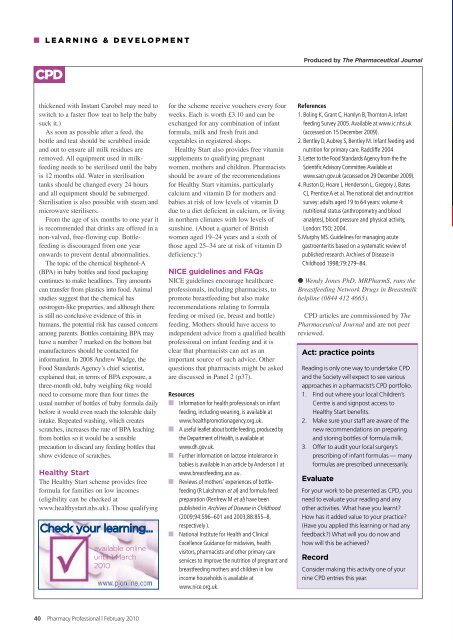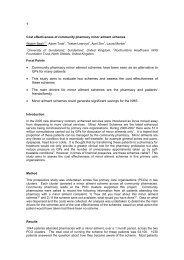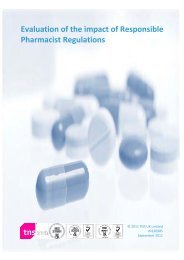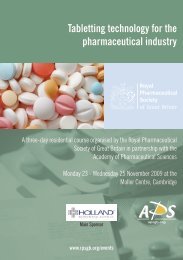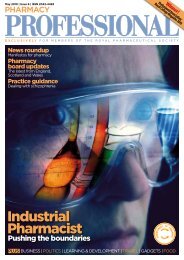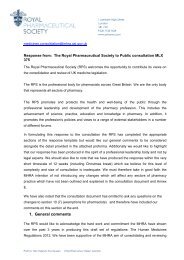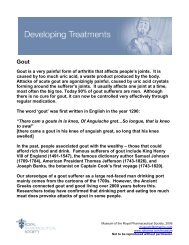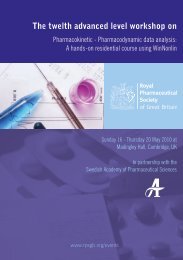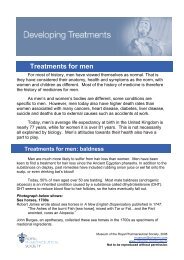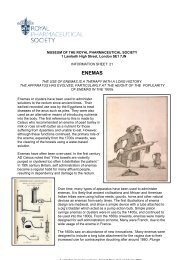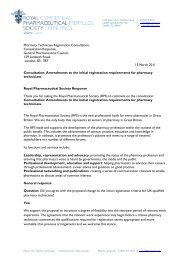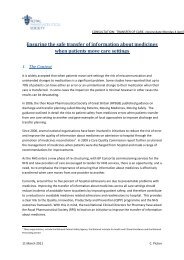Pharmacists in sport - Royal Pharmaceutical Society
Pharmacists in sport - Royal Pharmaceutical Society
Pharmacists in sport - Royal Pharmaceutical Society
You also want an ePaper? Increase the reach of your titles
YUMPU automatically turns print PDFs into web optimized ePapers that Google loves.
L E A R N I N G & D E V E L O P M E N T<br />
CPD<br />
Produced by The <strong>Pharmaceutical</strong> Journal<br />
thickened with Instant Carobel may need to<br />
switch to a faster flow teat to help the baby<br />
suck it.)<br />
As soon as possible after a feed, the<br />
bottle and teat should be scrubbed <strong>in</strong>side<br />
and out to ensure all milk residues are<br />
removed. All equipment used <strong>in</strong> milkfeed<strong>in</strong>g<br />
needs to be sterilised until the baby<br />
is 12 months old. Water <strong>in</strong> sterilisation<br />
tanks should be changed every 24 hours<br />
and all equipment should be submerged.<br />
Sterilisation is also possible with steam and<br />
microwave sterilisers.<br />
From the age of six months to one year it<br />
is recommended that dr<strong>in</strong>ks are offered <strong>in</strong> a<br />
non-valved, free-flow<strong>in</strong>g cup. Bottlefeed<strong>in</strong>g<br />
is discouraged from one year<br />
onwards to prevent dental abnormalities.<br />
The topic of the chemical bisphenol-A<br />
(BPA) <strong>in</strong> baby bottles and food packag<strong>in</strong>g<br />
cont<strong>in</strong>ues to make headl<strong>in</strong>es. T<strong>in</strong>y amounts<br />
can transfer from plastics <strong>in</strong>to food. Animal<br />
studies suggest that the chemical has<br />
oestrogen-like properties, and although there<br />
is still no conclusive evidence of this <strong>in</strong><br />
humans, the potential risk has caused concern<br />
among parents. Bottles conta<strong>in</strong><strong>in</strong>g BPA may<br />
have a number 7 marked on the bottom but<br />
manufacturers should be contacted for<br />
<strong>in</strong>formation. In 2008 Andrew Wadge, the<br />
Food Standards Agency’s chief scientist,<br />
expla<strong>in</strong>ed that, <strong>in</strong> terms of BPA exposure, a<br />
three-month old, baby weigh<strong>in</strong>g 6kg would<br />
need to consume more than four times the<br />
usual number of bottles of baby formula daily<br />
before it would even reach the tolerable daily<br />
<strong>in</strong>take. Repeated wash<strong>in</strong>g, which creates<br />
scratches, <strong>in</strong>creases the rate of BPA leach<strong>in</strong>g<br />
from bottles so it would be a sensible<br />
precaution to discard any feed<strong>in</strong>g bottles that<br />
show evidence of scratches.<br />
Healthy Start<br />
The Healthy Start scheme provides free<br />
formula for families on low <strong>in</strong>comes<br />
(eligibility can be checked at<br />
www.healthystart.nhs.uk). Those qualify<strong>in</strong>g<br />
Check your learn<strong>in</strong>g...<br />
available onl<strong>in</strong>e<br />
until 1 March<br />
2010<br />
for the scheme receive vouchers every four<br />
weeks. Each is worth £3.10 and can be<br />
exchanged for any comb<strong>in</strong>ation of <strong>in</strong>fant<br />
formula, milk and fresh fruit and<br />
vegetables <strong>in</strong> registered shops.<br />
Healthy Start also provides free vitam<strong>in</strong><br />
supplements to qualify<strong>in</strong>g pregnant<br />
women, mothers and children. <strong>Pharmacists</strong><br />
should be aware of the recommendations<br />
for Healthy Start vitam<strong>in</strong>s, particularly<br />
calcium and vitam<strong>in</strong> D for mothers and<br />
babies at risk of low levels of vitam<strong>in</strong> D<br />
due to a diet deficient <strong>in</strong> calcium, or liv<strong>in</strong>g<br />
<strong>in</strong> northern climates with low levels of<br />
sunsh<strong>in</strong>e. (About a quarter of British<br />
women aged 19–24 years and a sixth of<br />
those aged 25–34 are at risk of vitam<strong>in</strong> D<br />
deficiency. 4 )<br />
NICE guidel<strong>in</strong>es and FAQs<br />
NICE guidel<strong>in</strong>es encourage healthcare<br />
professionals, <strong>in</strong>clud<strong>in</strong>g pharmacists, to<br />
promote breastfeed<strong>in</strong>g but also make<br />
recommendations relat<strong>in</strong>g to formula<br />
feed<strong>in</strong>g or mixed (ie, breast and bottle)<br />
feed<strong>in</strong>g. Mothers should have access to<br />
<strong>in</strong>dependent advice from a qualified health<br />
professional on <strong>in</strong>fant feed<strong>in</strong>g and it is<br />
clear that pharmacists can act as an<br />
important source of such advice. Other<br />
questions that pharmacists might be asked<br />
are discussed <strong>in</strong> Panel 2 (p37).<br />
Resources<br />
■ Information for health professionals on <strong>in</strong>fant<br />
feed<strong>in</strong>g, <strong>in</strong>clud<strong>in</strong>g wean<strong>in</strong>g, is available at<br />
www.healthpromotionagency.org.uk.<br />
■ A useful leaflet about bottle feed<strong>in</strong>g,produced by<br />
the Department of Health,is available at<br />
www.dh.gov.uk.<br />
■ Further <strong>in</strong>formation on lactose <strong>in</strong>tolerance <strong>in</strong><br />
babies is available <strong>in</strong> an article by Anderson J at<br />
www.breastfeed<strong>in</strong>g.asn.au.<br />
■ Reviews of mothers’ experiences of bottlefeed<strong>in</strong>g<br />
(R Lakshman et al) and formula feed<br />
preparation (Renfrew M et al) have been<br />
published <strong>in</strong> Archives of Disease <strong>in</strong> Childhood<br />
(2009;94:596–601 and 2003;88:855–8,<br />
respectively ).<br />
■ National Institute for Health and Cl<strong>in</strong>ical<br />
Excellence Guidance for midwives, health<br />
visitors, pharmacists and other primary care<br />
services to improve the nutrition of pregnant and<br />
breastfeed<strong>in</strong>g mothers and children <strong>in</strong> low<br />
<strong>in</strong>come households is available at<br />
www.nice.org.uk.<br />
References<br />
1. Bol<strong>in</strong>g K, Grant C, Hamlyn B,Thornton A. Infant<br />
feed<strong>in</strong>g Survey 2005.Available at www.ic.nhs.uk<br />
(accessed on 15 December 2009).<br />
2. Bentley D,Aubrey S, Bentley M. Infant feed<strong>in</strong>g and<br />
nutrition for primary care. Radcliffe 2004<br />
3. Letter to the Food Standards Agency from the the<br />
Scientific Advisory Committee.Available at<br />
www.sacn.gov.uk (accessed on 29 December 2009).<br />
4. Ruston D, Hoare J, Henderson L, Gregory J, Bates<br />
CJ, Prentice A et al.The national diet and nutrition<br />
survey: adults aged 19 to 64 years: volume 4:<br />
nutritional status (anthropometry and blood<br />
analytes), blood pressure and physical activity,<br />
London:TSO; 2004.<br />
5.Murphy MS. Guidel<strong>in</strong>es for manag<strong>in</strong>g acute<br />
gastroenteritis based on a systematic review of<br />
published research.Archives of Disease <strong>in</strong><br />
Childhood 1998;79:279–84.<br />
● Wendy Jones PhD, MRPharmS, runs the<br />
Breastfeed<strong>in</strong>g Network Drugs <strong>in</strong> Breastmilk<br />
helpl<strong>in</strong>e (0844 412 4665).<br />
CPD articles are commissioned by The<br />
<strong>Pharmaceutical</strong> Journal and are not peer<br />
reviewed.<br />
Act: practice po<strong>in</strong>ts<br />
Read<strong>in</strong>g is only one way to undertake CPD<br />
and the <strong>Society</strong> will expect to see various<br />
approaches <strong>in</strong> a pharmacist’s CPD portfolio.<br />
1. F<strong>in</strong>d out where your local Children’s<br />
Centre is and signpost access to<br />
Healthy Start benefits.<br />
2. Make sure your staff are aware of the<br />
new recommendations on prepar<strong>in</strong>g<br />
and stor<strong>in</strong>g bottles of formula milk.<br />
3. Offer to audit your local surgery’s<br />
prescrib<strong>in</strong>g of <strong>in</strong>fant formulas — many<br />
formulas are prescribed unnecessarily.<br />
Evaluate<br />
For your work to be presented as CPD, you<br />
need to evaluate your read<strong>in</strong>g and any<br />
other activities. What have you learnt?<br />
How has it added value to your practice?<br />
(Have you applied this learn<strong>in</strong>g or had any<br />
feedback?) What will you do now and<br />
how will this be achieved?<br />
Record<br />
Consider mak<strong>in</strong>g this activity one of your<br />
n<strong>in</strong>e CPD entries this year.<br />
40<br />
Pharmacy Professional | February 2010


